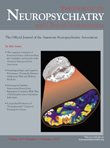A Case of Idiopathic Basal Ganglia Calcification Presenting With Only Acting-Out Attacks and Mild Cognitive Impairment: PET Findings
SIR: A patient with idiopathic calcification of the basal ganglia manifested acting-out attacks and mild cognitive impairment beginning at age 34. Computed tomography (CT) showed bilateral calcifications in the putamen and globus pallidus consistent with the diagnosis of Fahr’s disease. In contrast, reduced glucose uptake in positron emission tomography (PET) was not just confined to the areas mentioned above, but extended to the temporal and parietal and cerebellar regions. Our findings suggest that the cerebellum, striatum, and their cortical connections perform a global functional unit capable of influencing not only the motor behavior but also the cognitive and emotional functions.
Fahr’s disease (basal ganglia calcification) is a rare neurodegenerative disorder characterized by bihemispherical calcium deposits, especially in the basal ganglia. 1 Its clinical manifestations are a rigid hypokinetic syndrome, psychiatric symptoms, and cognitive impairment. 1 Clinical diagnosis is facilitated by the presence of bilateral calcifications in the basal ganglia in CT. However, for the correct diagnosis, these calcifications may not be explained by any particular disorder of the calcium phosphorus metabolism or other diseases.
Case Report
The patient was admitted to the University of Uludag with acting-out attacks and difficulty in concentration. The patient also had episodes of violence precipitated by little provocation. During the examination the patient showed appropriate emotional display. The speech was found to be normal except that it was spoken in an aggressive voice and interrupted sometimes by word-finding difficulties. Psychiatric and neurological examinations were otherwise normal. By neuropsychological evaluation, the Benton test (Instruction F) 2 revealed mild to moderate disturbance in selective attention and concentration. On the Wechsler Memory Intelligence Scale, the patient exhibited mild to moderate impairment regarding logical memory, working memory, visual memory, and attention.
CT and magnetic resonance imaging (MRI) showed a bilateral calcification of the putamen and globus pallidus consistent with Fahr’s disease, but no pronounced brain atrophy was observed. In contrast, reduced glucose uptake in PET was not only restricted to the left basal ganglia, but also involved the right temporoparietal and the right cerebellar cortices corresponding to the impaired cognitive flexibility, figural, and working memory. Secondary causes of the calcifications were excluded by laboratory testing.
Comment
The basal ganglia and cerebellum have traditionally been associated with motor performance. Though the neuronal activity within the basal ganglia and cerebellar loops with motor areas of the cerebral cortex were found to be highly correlated with parameters of movement, the aspects of cognitive function were found to be more related to the activity within the basal ganglia and cerebellar loops. 3
In our case, functional abnormalities did not entirely parallel morphological changes, and were also found in the temporal parietal and cerebellar regions which appeared to be rather unaffected in CT and MRI.
This indicates that the reduced glucose uptake observed in the respective regions may reflect secondary deficits due to diminished functions of circuits involving the basal ganglia. However, in addition to suggesting the existence of an functional network between the ipsi and contralateral corticosubcortical regions, our findings also indicate the possible role of the cerebellum in emotional and cognitive functions. 4 – 6
In conclusion, we present an atypical presentation of presumed cognitive impairment and emotional incontinency in a 34-year-old man and the correlation of the metabolic changes seen with his change in cognitive and emotional state. This type of quantitative analysis can provide that information, unlike a subjective radiological evaluation limited with MRI and CT. A greater understanding of the functional activity of the underlying regions affected by Fahr’s syndrome may help to provide insight into specific networks involved.
1 . Trautner RJ, Cummings JL, Read SL, et al: Idiopathic basal ganglia calcification and organic mood disorder. Am J Psychiatry 1988; 145:350–353Google Scholar
2 . Benton AL: Neuropsychological assessment. Ann Rev Psychol 1994; 45:1–23Google Scholar
3 . Middleton FA, Strick PL: Basal ganglia and cerebellar loops: motor and cognitive circuits. Brain. Res. Rev 2000; 31:236–250Google Scholar
4 . Schmahmann JD, Sherman JC: The cerebellar cognitive-affective syndrome. Brain 1998; 121:561–579Google Scholar
5 . Rapoport M, van Reekum R, Mayberg H: The role of the cerebellum in cognition and behavior: a selective review. J Neuropsychiatry Clin Neurosci 2000; 12:193–198Google Scholar
6 . Schmahmann JD: Disorders of the cerebellum: ataxia, dysmetria of thought, and the cerebellar cognitive affective syndrome. J Neuropsychiatry Clin Neurosci 2004; 16:367–378Google Scholar



